Going through a lengthy period of digression, Ipswich Town were in desperate need to inject some energy into the men’s first-team following the unfortunate dismissal of Paul Cook.
Following ultimately disappointing spells from Mick McCarthy, Paul Hurst, Paul Lambert and Cook, the board decided to go for a young, fresher manager – preferably one whose forename wasn’t Paul.
Kieran McKenna was the surprise choice by the club’s hierarchy.
The Northern Irishman built a massive reputation for himself in football, from retiring from the sport at just 23 after sustaining a career-ending injury, to becoming an assistant coach at Manchester United.
McKenna was originally the Under-18s head coach at both Tottenham Hotspur and United until the legendary Portuguese manager Jose Mourinho decided that the Loughborough University graduate was good enough to make the giant leap to the first-team.
Quickly McKenna learned, adapted and improved and became an integral part of the coaching staff of both Mourinho and his successor Ole Gunnar Solskjær.
McKenna had just begun his new role under Ralf Rangnick, following Solskjær’s departure, until Ipswich came knocking.
The young coach couldn’t turn down the opportunity of his first managerial job in the professional game and so swiftly accepted the proposal.
Six games into his incumbency, McKenna has guided the Blues to four wins – a solid start for a struggling side – while playing some utterly scintillating football in possession.
This article will be a tactical analysis of Ipswich under the 35-year-old.
It will be an analysis of the side’s tactics with a focus on their principles in possession.
Formation choice and preferred style
Under Cook, Ipswich were setting up in the 4-2-3-1.
The Blues deployed this conventional formation in 46 percent of their matches this season, although a plethora of other structures have been seen at Portman Road.
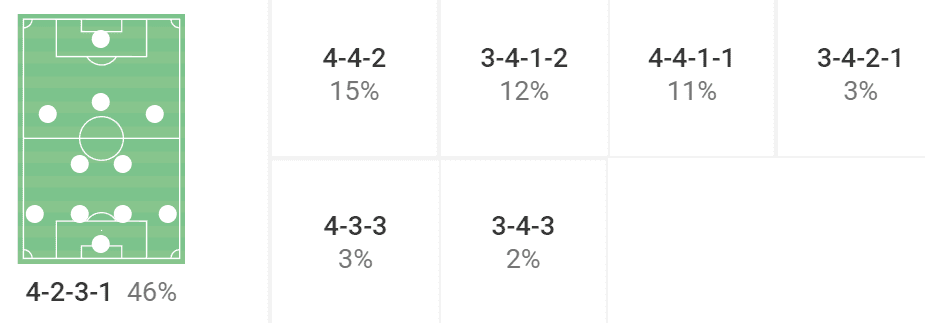
Following Cook’s departure, John McGreal briefly took over as the club’s interim head coach prior to McKenna’s arrival.
McGreal had continued with the 4-2-3-1 but later switched to the 4-4-2 and eventually the 3-4-1-2 before moving aside for the new boss.
McKenna, in his first six matches so far, has opted to set his side up in a 3-4-1-2 at times with the experienced Sone Aluko roaming as the number ‘10’, but the new coach has also arranged his team in a 3-4-2-1 with two wingers playing narrowly alongside the centre-forward.
The Northern Irish manager has even switched between the two tactical structures during games:
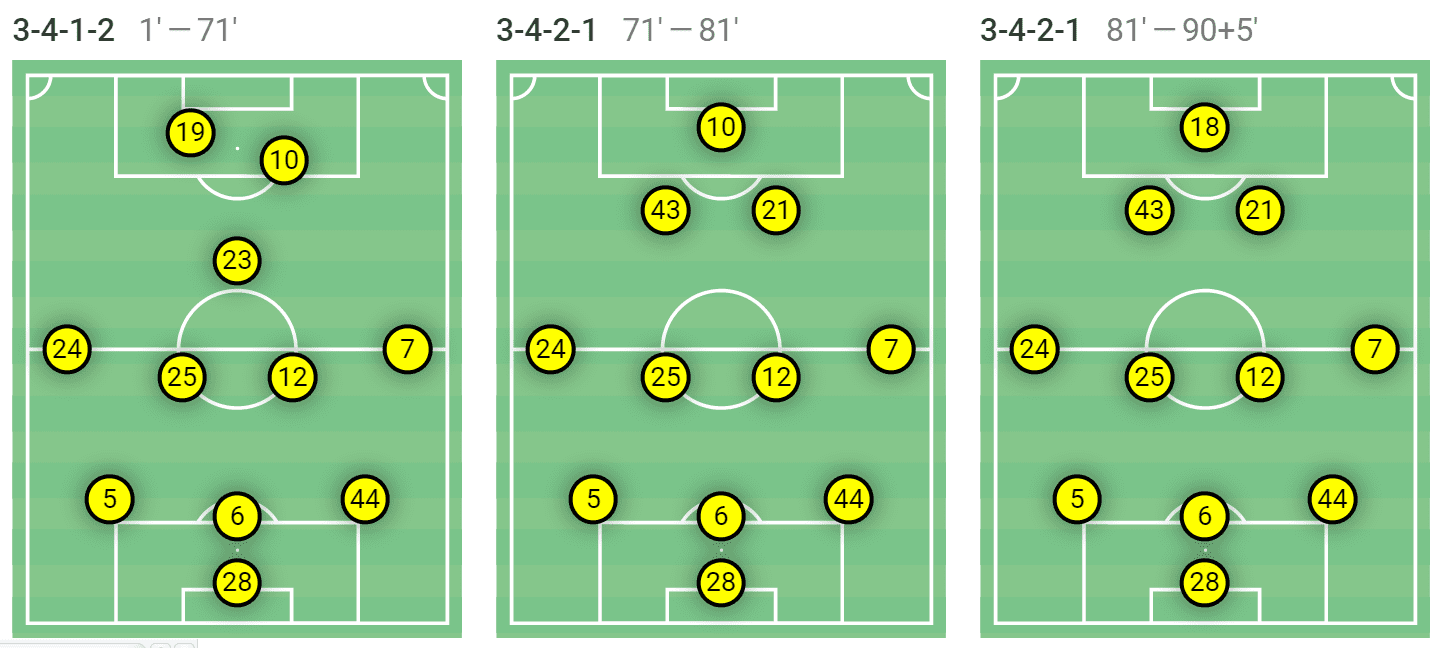
This image details how McKenna switched from a 3-4-1-2 to a 3-4-2-1 in a recent match against AFC Wimbledon.
The change was made at 1-0 and the game ended 2-0 – nicely played by the tactician to see out the game and make sure of the three points.
These two systems have been preferred by the young coach since his arrival and at least one has been used in every match of his tenure so far.
McKenna has also been no stranger to the 3-5-2/5-3-2 but has merely shifted to this formation when Ipswich are trying to see a game out and need to drop deeper.
In possession though, the base formation becomes flexible and quite irrelevant for the most part.
It takes many different forms, shapes and sizes which will be analysed in further sections.
Build-up play
Like most modern coaches, McKenna has made it clear since day one that he wants Ipswich to attempt to play out from the back.
In a back three, when in the build-up phase of the attack, the structure needs to be lopsided with one centre-back pushing wider in order to accommodate the ball-playing goalkeeper.
McKenna generally instructs his right centre-back, Janoi Donacien, to fulfil this role, facilitating the keeper’s involvement.
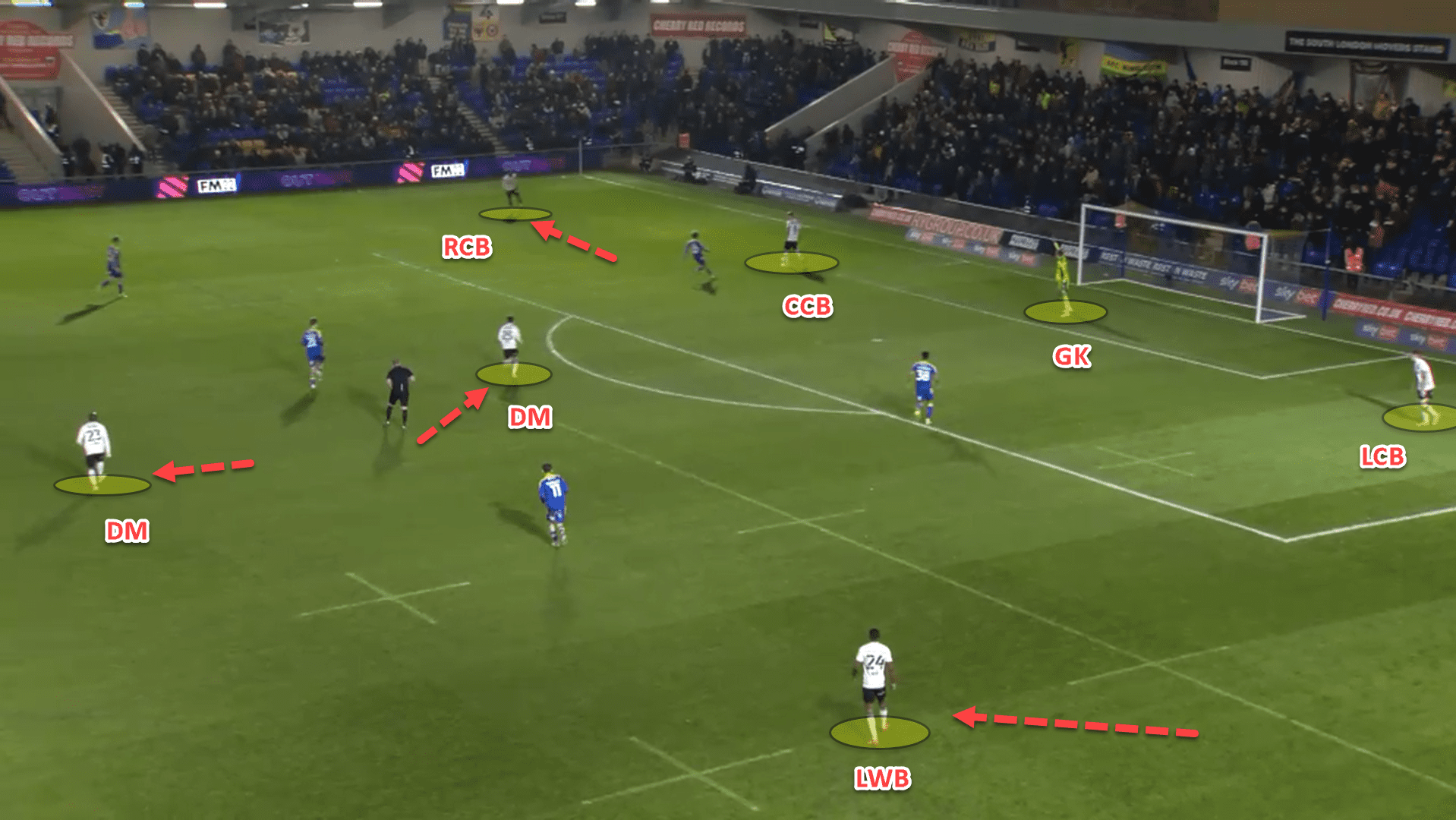
The wingbacks position themselves relatively high during this phase but drop short if the ball-near centre-back is looking to play the ball to them.
This centre-back to wingback pass is vital for Ipswich’s build-up as it helps them to play around a high press.
Behind the opposition’s first line of pressure, the central midfielders move a lot, dragging markers with them in order to create space, but there is also an emphasis that, whoever is playing the midfield, needs to constantly look for the ball to feet.
Wide centre-back to wingback, inside to ball-near central midfielder and then up to the frontline is a passing pattern that Ipswich have used quite a lot under McKenna so far to great success when playing out from the back – a variation of the ‘up-back-through’ passing pattern.
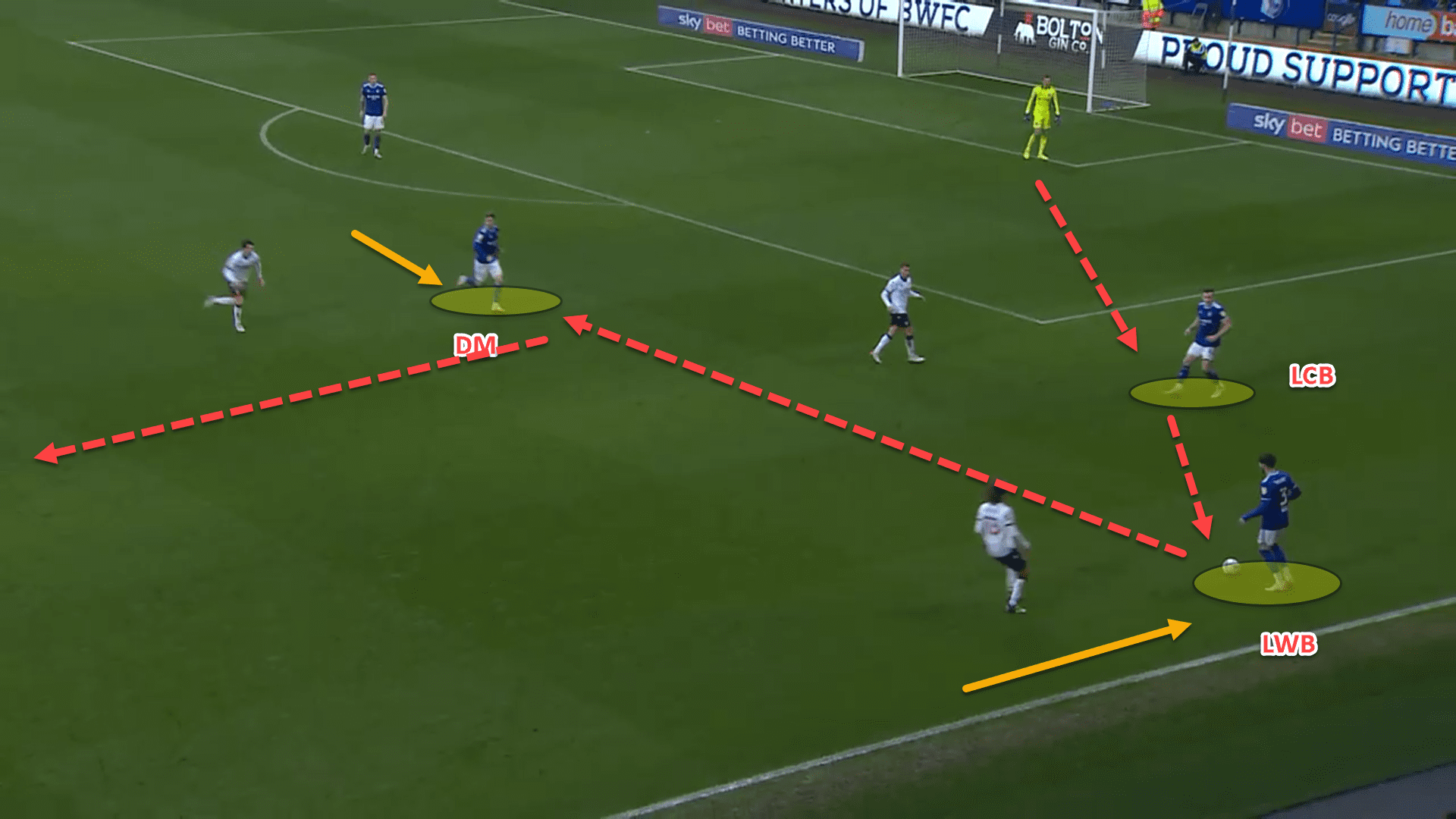
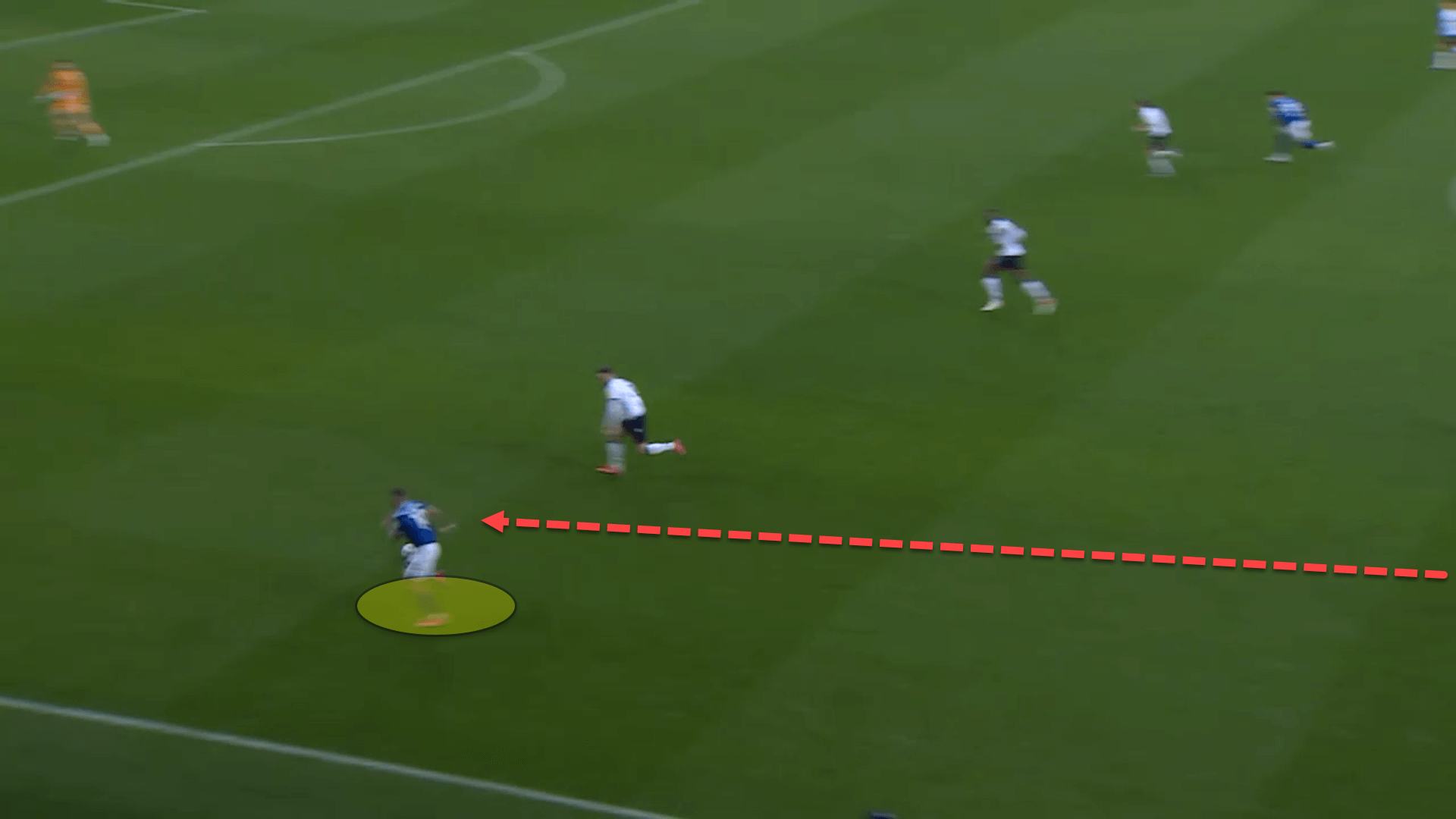
Ipswich performed this efficient passing pattern to perfection here.
The ball from Tom Carroll in midfield was hit first-time into the channel where a centre-forward could latch onto it in behind the opponent’s defensive line.
McKenna wants the build-up to be fast and efficient.
There is an emphasis on getting the ball forward as quickly as possible.
Particularly at a level like League One, players can make mistakes in the build-up of attacks compared to the Premier League and so it is important that coaches can allow for simplistic patterns and even give license to their players to go long.
McKenna has no issue with this.
In fact, despite instructing his players to play from deep on the floor where possible, the Northern Irishman’s side are averaging 54.7 long passes per 90 which makes up 17.4 percent of Ipswich’s overall passes under the new manager.
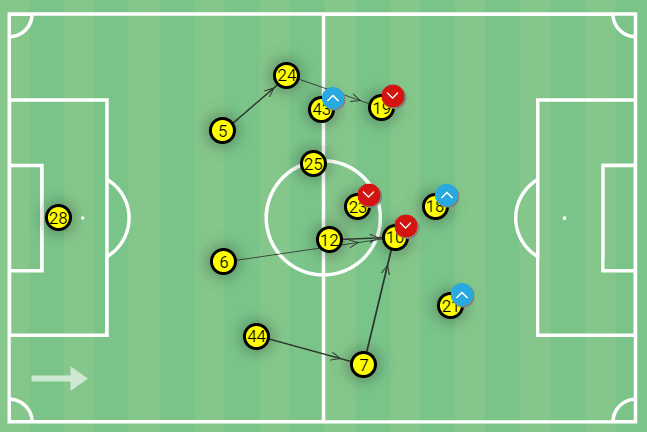
Here is a pass map from Ipswich’s recent league fixture away to Wimbledon which highlights all of the team’s most frequent progressive passes.
What’s very visible from the map is the clear emphasis on progression from the centre-backs.
The wide defenders were progressing the ball to the wingbacks while the central defender was going direct to the centre-forward.
When Ipswich do take the option to go long from deeper areas instead of trying to play out, there is always a method behind it, proving just how well-structured the side have been since the inexperienced manager took over in the dugout.
The players swarm the ball carrier, offering depth and support, trying to give themselves the best possible chance to win the second balls.
Macauley Bonne, the prolific Zimbabwean striker on loan from QPR, is usually the aim.
While Bonne is not the most aerially dominant or tallest player in the league, he still troubles defenders by using his body well.
The 26-year-old makes a solid ‘target’ upfront.
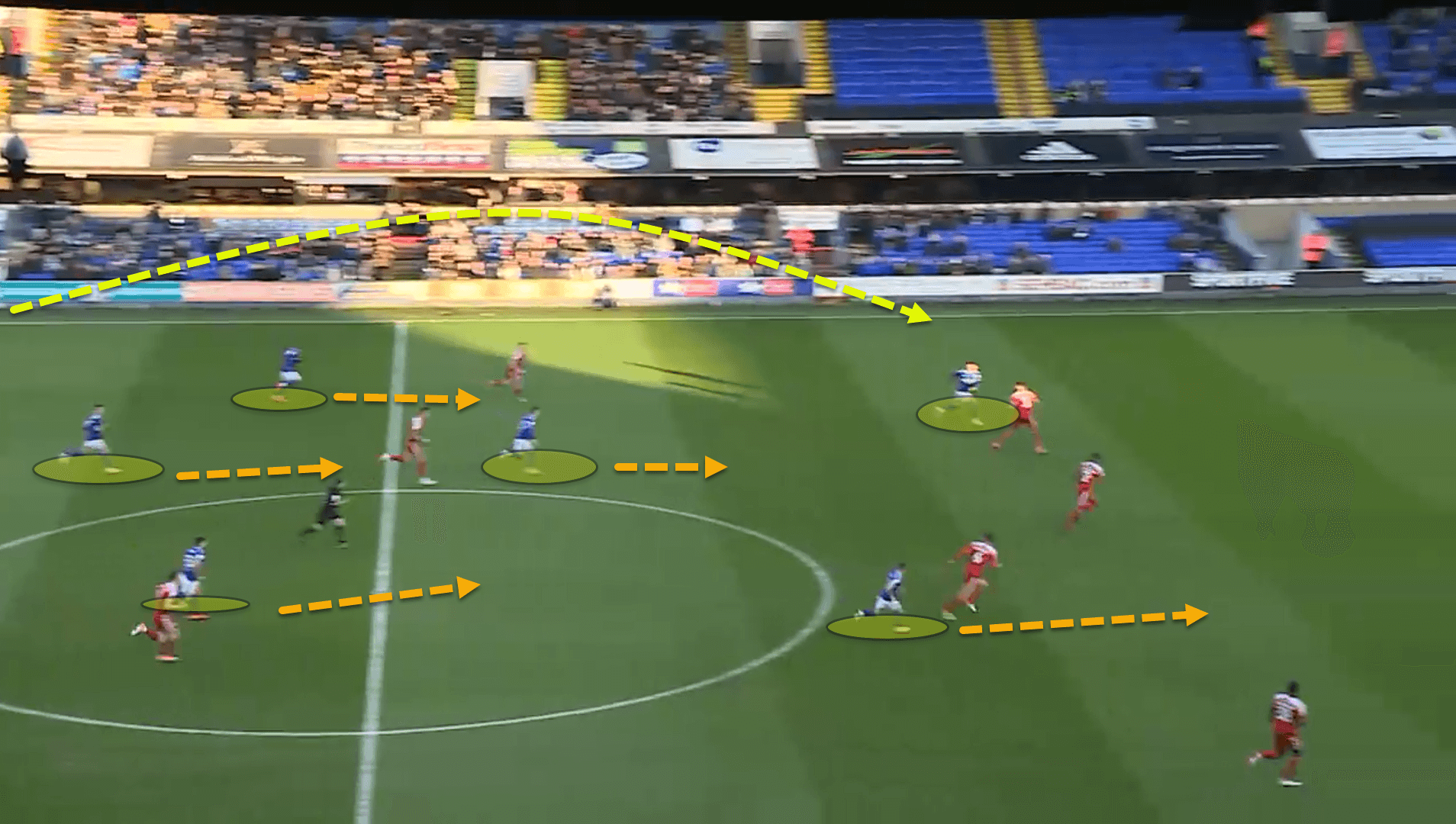
In this image, from a home game against Accrington Stanley, Ipswich used goalkeeper Chris Walton’s fine passing range to go long to the forward line.
Instantly, the rest of the team pushed up to surround the ball with bodies, while having a man running in behind, ensuring that there was depth in behind and support in front.
This must be executed in unison to give the side the best possible chance of winning the second ball but can be a wonderful alternative to progress the side high up the pitch quickly – a rather old-school, Charles Reep-esque approach to ball progression.
McKenna has made Ipswich flexible.
They can play both short, and direct, through a press and over a press.
As Eleanor Roosevelt once said: “Be flexible but stick to your principles”.
The new head coach is certainly adhering to these famous words thus far.
Overlapping centre-backs and halfspace crosses
There is a noticeable pattern in the English Football League system that a plethora of managers, particularly those deploying a back three, are willing to push at least one centre-back forward once the team reaches the final third.
This is quite an interesting tactical observation because it’s rather rare to see in the Premier League since Sheffield United were relegated and very few top European sides have adopted the unconventional tactic with the exceptions of Internazionale and perhaps Chelsea at a stretch.
Nevertheless, in the EFL, Ipswich, Middlesbrough, MK Dons, Swansea City, among a whole host of others have adopted the tactical component, made famous by Chris Wilder (now Boro boss) during his stint with the Blades.
For Ipswich, Donacien has been instructed to perform this function whilst the Blues are in possession.
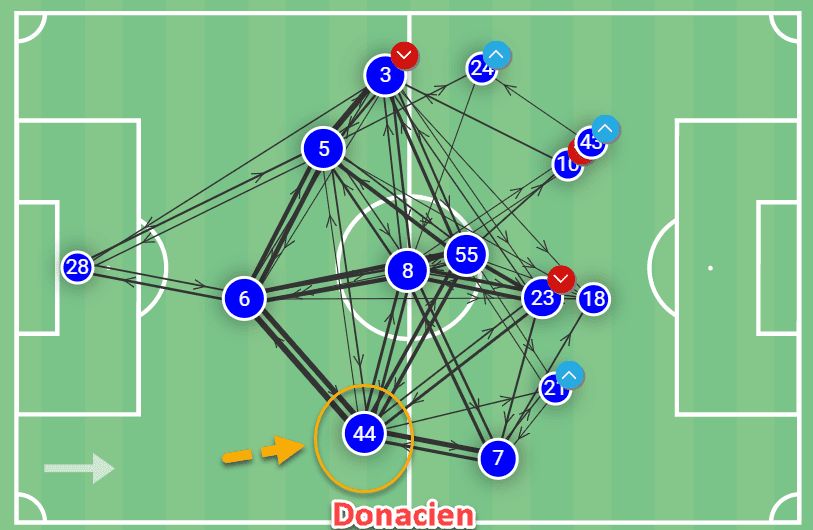
Looking at Ipswich’s pass map from a recent match against Bolton Wanderers, it’s vehemently obvious that Donacien is pushing much further forward than the two other central defenders.
There are different ways for a centre-back to get involved in the final third.
Some managers do not want their wide central defenders making overlapping runs in behind to offer another attacking option on the flanks and so these teams will move the ball-near centre-back close to the play but ensuring that they stay under the ball.
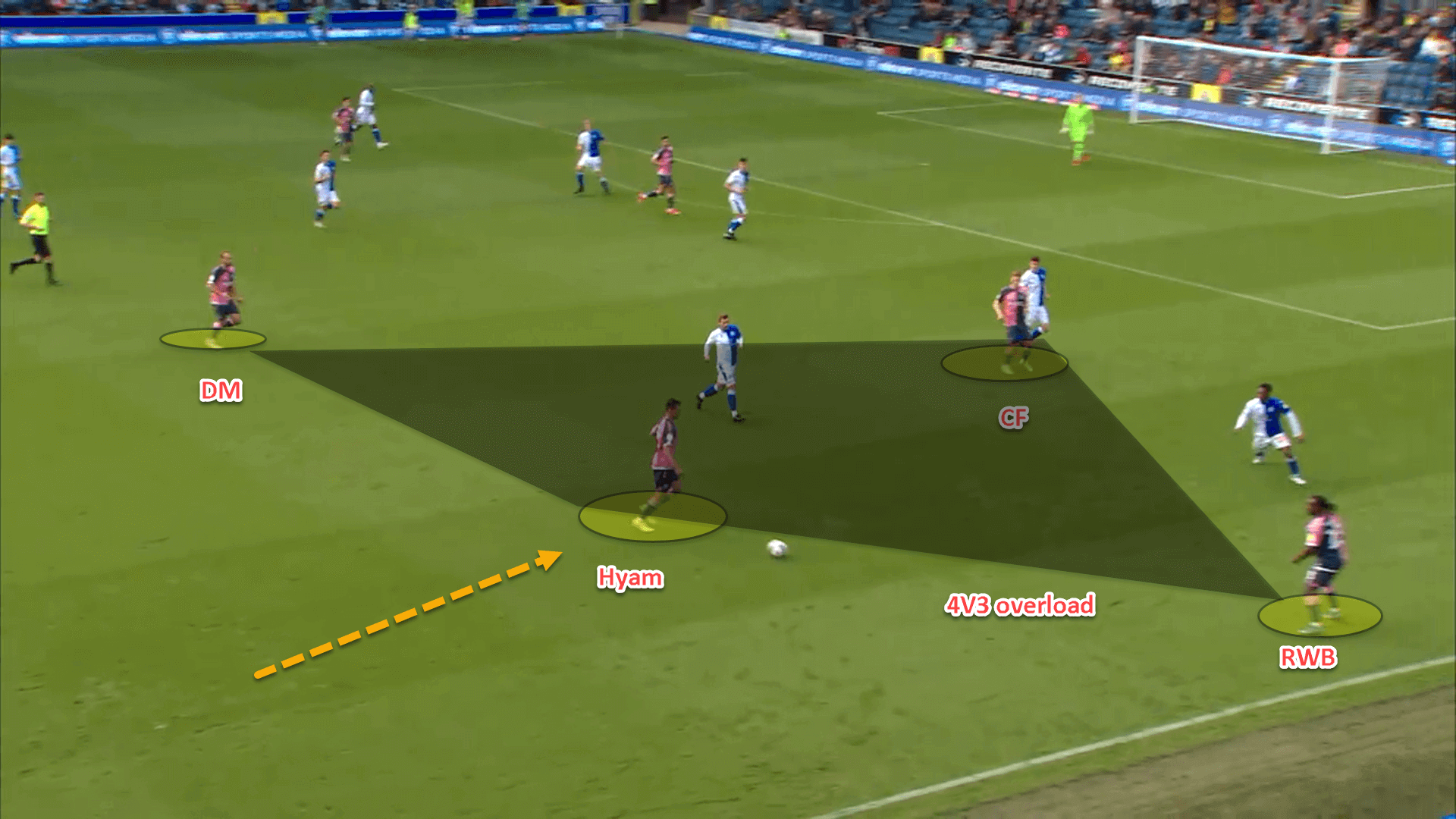
For instance, in this image, Coventry City’s centre-back Dominic Hyam has pushed forward on the right halfspace to create a 4v3 overload against Blackburn Rovers’ defensive block.
Nevertheless, Hyam wouldn’t overstep his mark and venture further forward.
However, there are managers that like their centre-backs to do so.
This allows them to have an extra option out wide to provide crosses into the penalty area.
It also facilitates wide overloads and so the team in possession will almost always have a free man on the wings.
In order to be useful in this role, the wide defender must be comfortable at providing attacking output.
Having players capable of filling in at right-back is very useful for this tactic to be employed.
Donacien’s preferred position is as a fullback and so being an overlapping/attacking fullback is almost second-nature for the St Lucian which is why McKenna has been able to attack with him.
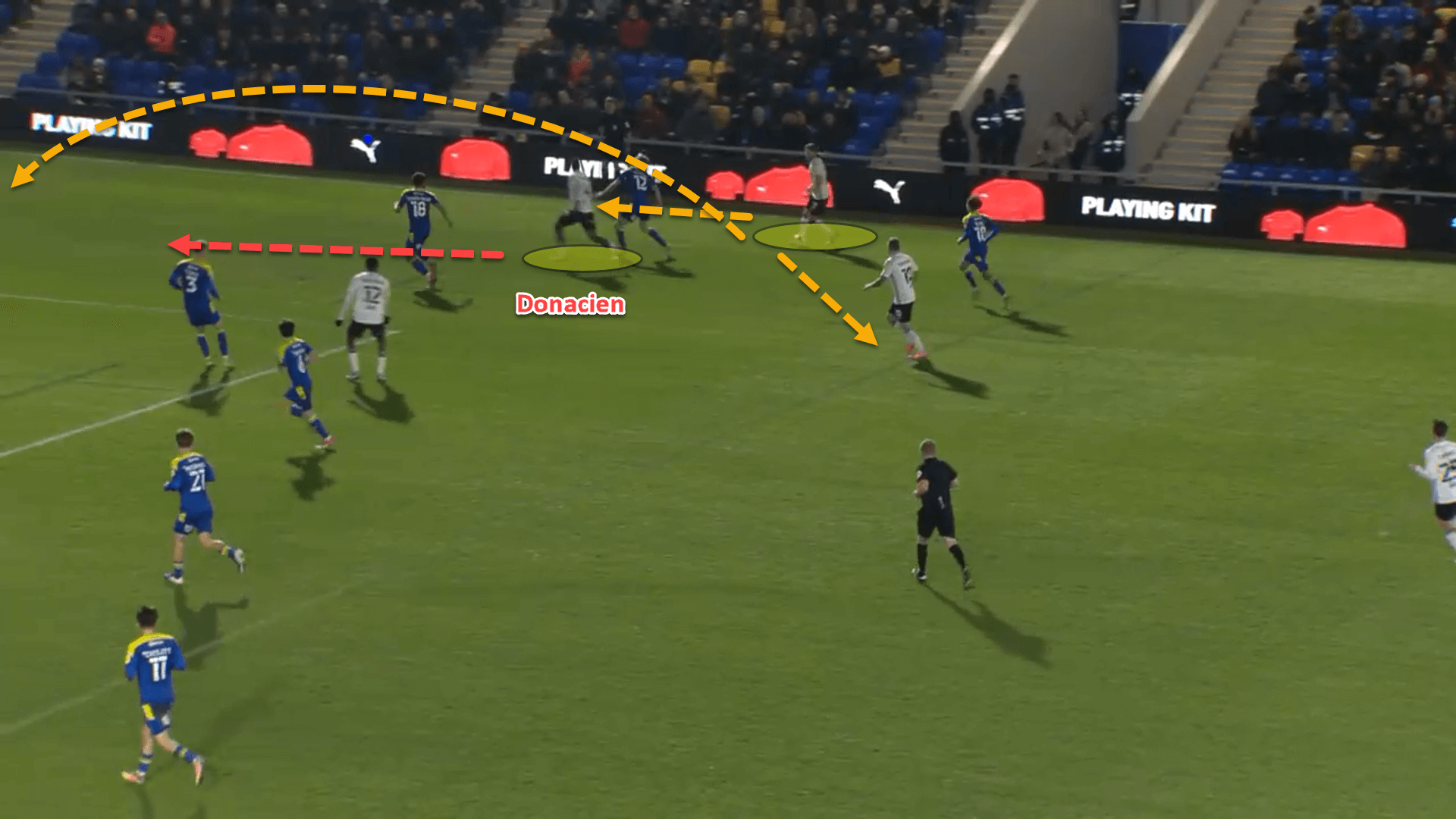
Here, the defender has made a run in behind Wimbledon’s backline, dragging two defenders with him in the meantime.
His teammate on the ball now has three options: They can either slip Donacien in as he runs into a crossing position, square the ball to the player who is standing in a good position behind the play, or else cross it himself.
Having a centre-back being an extra man on the flank has allowed a plethora of options to open up, giving the team a variety of different ways to attack the opposition – a great way to break down a low block once executed deftly.
Ipswich attack down the flanks consistently for this very reason:
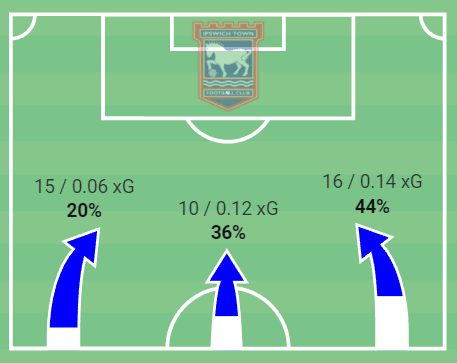
This data visualisation highlights where all of Ipswich’s 41 positional attacks came from in a match against Bolton in January.
31 from 41 were out wide while the team were most effective from the right-wing overall.
Having the right centre-back get involved in the attacking plan has certainly been a key principle to Ipswich’s attacking play and is joyous to watch from both a neutral and analytical perspective.
Crossing is Ipswich’s primary tool for chance creation under McKenna.
The Blues are averaging 14.5 crosses per 90 under the 35-year-old coach.
Ipswich try to create plenty of crossing opportunities in the halfspaces.
In this regard, McKenna has taken a page right out of the Pep Guardiola book of coaching.
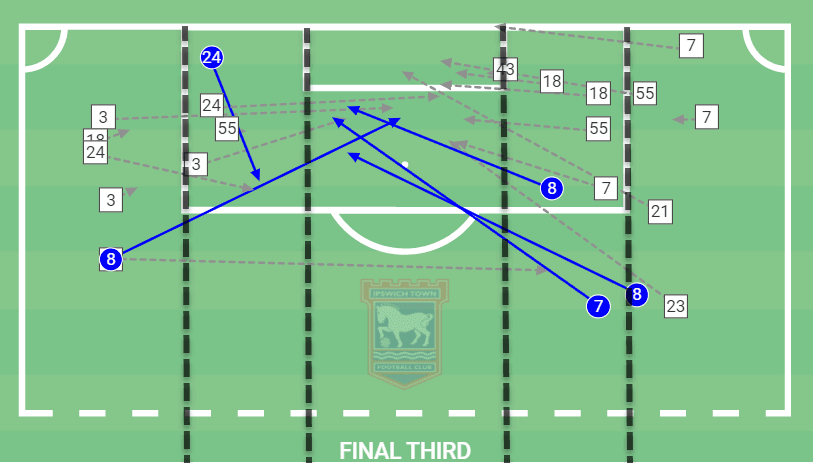
This data visual plots all of Ipswich’s 23 crosses against Bolton.
11 of these crosses were in the halfspace while none were very close to the touchline, proving that there is an emphasis from the manager that he wants his players to try and cross close to the goal, giving them a higher percentage chance to score from as opposed to a high cross from the sideline.
The role of Tom Carroll in breaking down a defensive block
When a team is breaking down a defensive block, it will not always be cut and dry.
Sometimes the players will try attacking on the wings but may be cut off by the opposition’s defence and will be forced to re-circulate the ball.
Re-circulation is an important, and very underrated element behind breaking down a deep defensive structure.
Former Tottenham Hotspur man Tom Carroll has been instrumental for McKenna’s side in doing this.
The English midfielder is very adept at receiving the ball from one flank and quickly switching it to the other in order to find holes in the opponent’s shape.
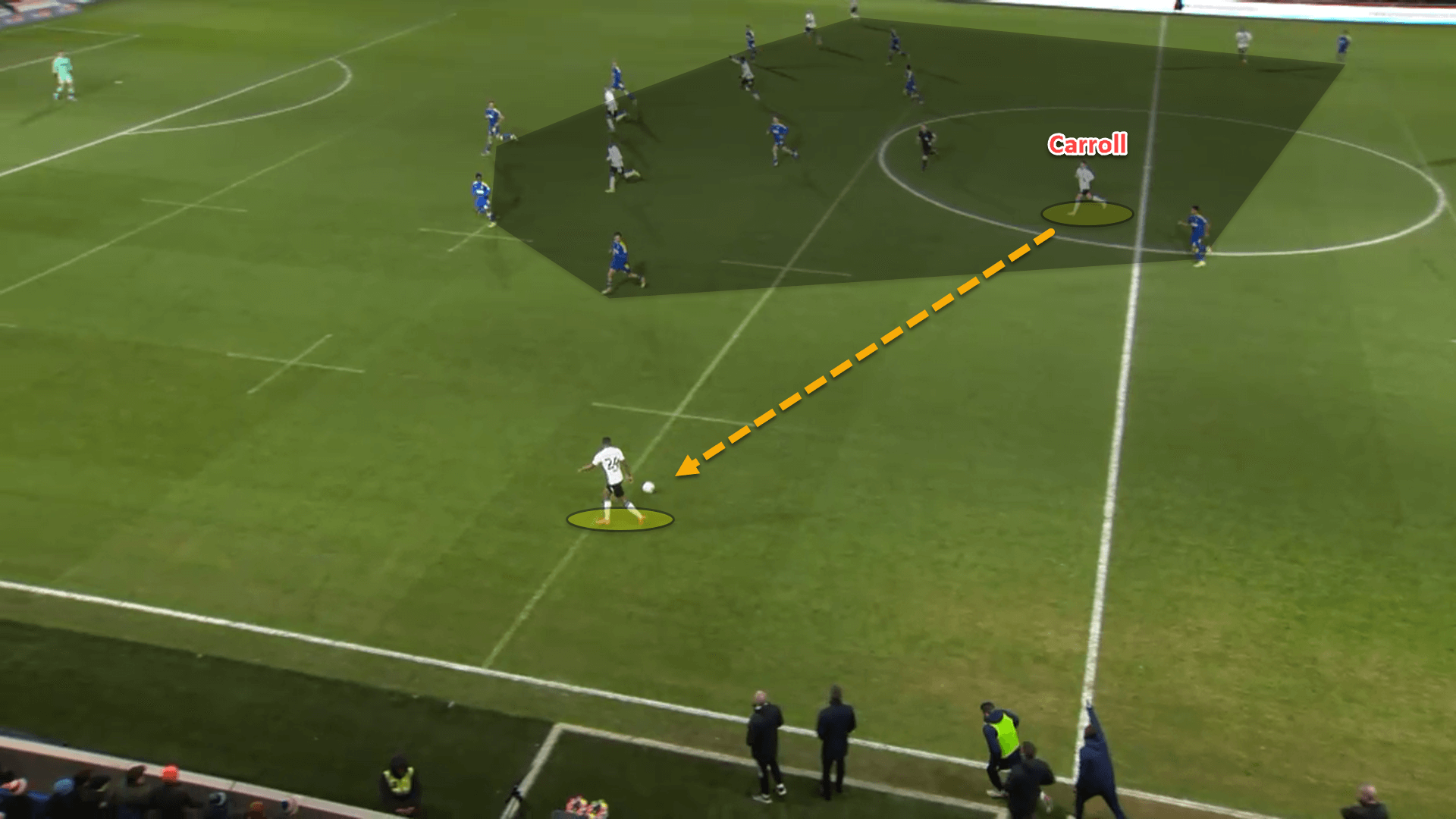
Carroll has a sumptuous passing range for a team playing in League One and so McKenna was very fortunate in this sense as there was already a player in the squad with the capability to provide constant switches of play.
When the ball is switched quickly, the opponent must quickly shift their defensive block from one side to another which opens up little gaps to play through.
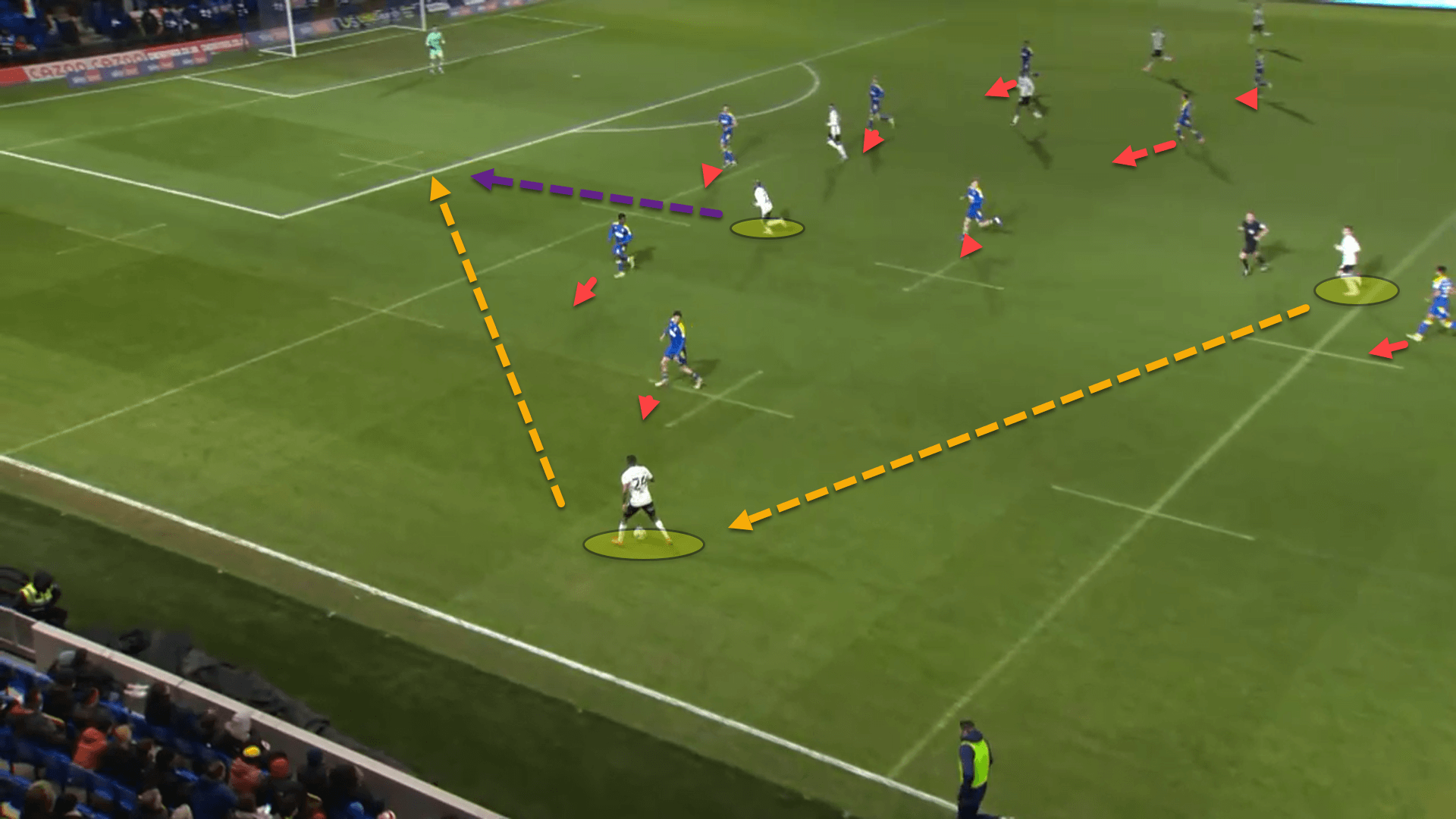
But the key is to have a player capable of switching the ball at rapid speed with precision which Carroll does well for the Blues.
Not only this, but Carroll can also be the key to unlocking a defensive structure throughout games.
On more than a couple of occasions under the new manager, the 29-year-old midfielder has provided some key passes which have completely opened up the opponent’s backline.
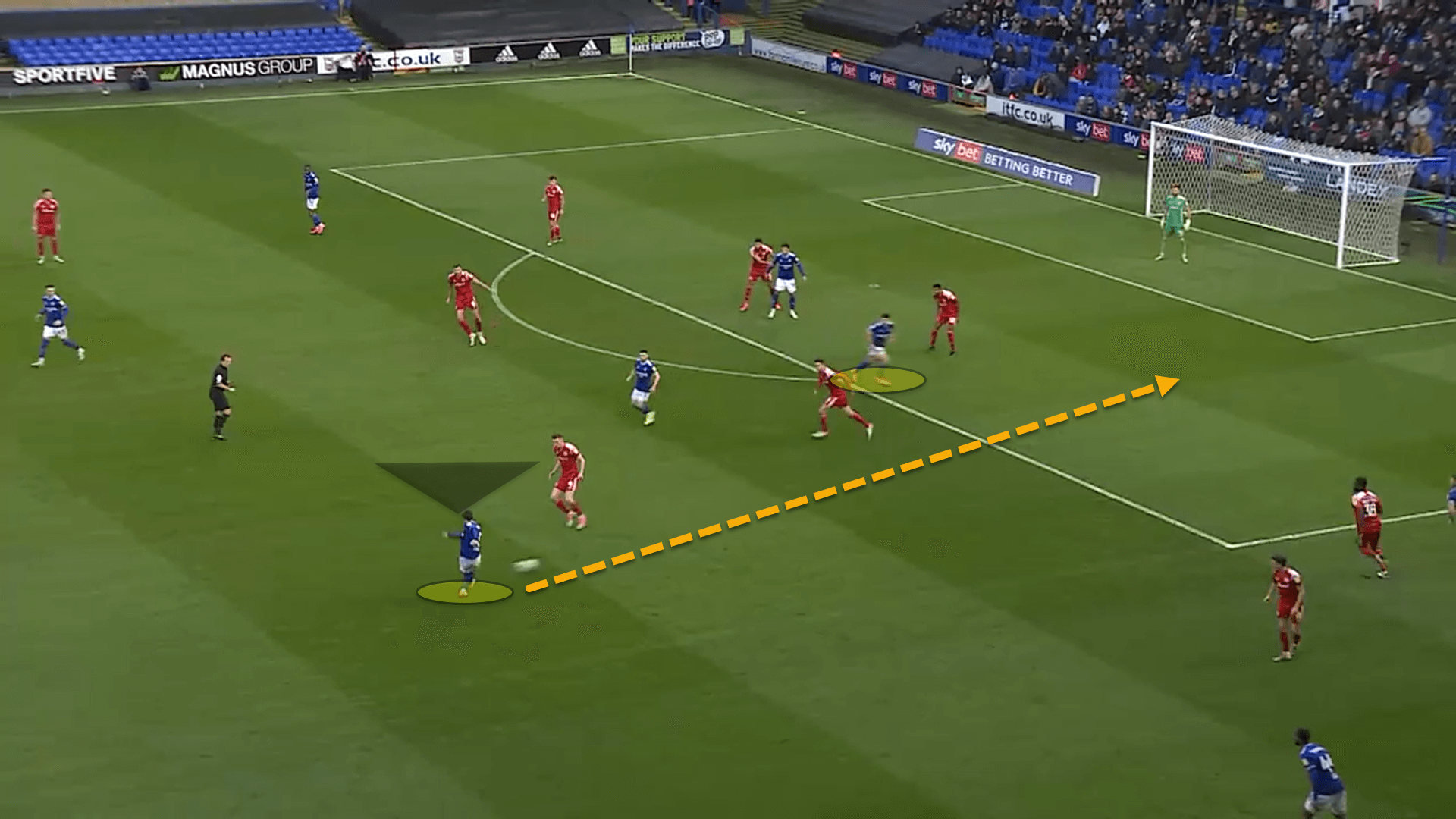
Here’s just one example of these hidden through passes that Carroll attempts to play on a regular basis.
The midfielder is looking off to the left flank and angles his body to suit this narrative before sliding a beautiful ball into a gap behind Accrington Stanley’s backline.
This is a tremendous attribute to have for a midfielder as even players at the highest level in football are unable to perform such a skill.
Sergio Busquets is undoubtedly the master at it and, of course, while Carroll is incomparable to the Barcelona great, they perform a very similar function for their respective sides.
Where Xavi Hernandez has Busquets, Kieran McKenna has Carroll.
Both are operating on very different levels, but the pair are equally as important to their new managers.
Conclusion
Ipswich Town are certainly a team that football purists should keep an eye on.
While the Blues are still really rough around the edges, McKenna has already implemented a clear plan in possession which was lacking under Paul Cook earlier in the season.
The sample size is far too small right now to predict whether the young coach and the struggling side from Portman Road are a good fit.
However, at the moment, they are enjoying each other’s company and the fans are being treated to some poetic, if not slightly inconsistent, possession-based football.






Comments